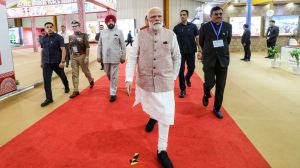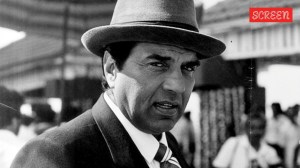125th birth anniversary of Pierre Jeanneret: City college to mark legacy of the Swiss architect
Jeanneret, who served as the first Chief Architect of Chandigarh, is fondly remembered as an unassuming figure, the handyman who had an eye for detail.
 Chandigarh College of Architecture Principal Sangeeta Bagga in front of a picutre of Pierre Jeannette on campus. (Express Photo by Kamleshwar Singh)
Chandigarh College of Architecture Principal Sangeeta Bagga in front of a picutre of Pierre Jeannette on campus. (Express Photo by Kamleshwar Singh)The legendary Swiss architect Le Corbusier had once noted, “My cousin Pierre Jeanneret: discernment, talent and loyalty. In Chandigarh, he had a difficult task. Without Pierre Jeanneret, this city would surely not appear today as a symbol of modern times… And the architecture Corbusier in Chandigarh would probably not even exist.”
When Corbusier was roped in for the development of the UT by Chief Administrator PL Varma and State Administrator PN Thapar, he had a proviso. He would only agree to work if he were joined by his younger cousin, Jeanneret, on the project. The latter, a versatile and detail-oriented architect, played a key role in the realisation of the Chandigarh Capital Project.
The Chandigarh College of Architecture which is paying homage to the legendary Swiss architect in a two-hour long programme, will host a presentation to explore the essence of modernism in Jeanneret’s works.
Dr Sangeeta Bagga Mehta, Principal (CCA-12), shares, “On the occasion of his 125th birth anniversary, we are organising a programme called, ‘Commemorating the legacy of Pierre Jeanneret’. The presentation would dwell upon the way he utilised material to create the architecture of this city, and how he was able to encapsulate the essence of modernism in his works.”
Kapil Setia, the Chief Architect of Chandigarh, is scheduled to give a presentation, which would be focused on the oeuvre of Pierre Jeanneret in the city. Meanwhile, Dr Sandeep Goyal, a Mumbai-based philanthropist, will launch the ‘Le Corbusier and Pierre Jeanneret Forum’, a forum especially for those who admire the architectural richness and aesthetic beauty and design of the city. He will also speak about his vision to restore and preserve the architecture of Chandigarh. Goyal shares, “I am also initiating an exercise, under the forum, to identify, photograph, chronicle and archive the finest Corbusier-Jeanneret structures in the city.”
Harking back to the early 1950s, Dr Bagga says, “The development of Chandigarh marked the birth of modern architecture in India.” She adds, “Jeanneret would make use of indigenous materials and non-mechanised methods, and imbued his style of architecture with the western ethos. The differentiation of urban functions has been adopted from the west. In Chandigarh, we have well-differentiated commercial and residential areas. Jeanneret was ahead of the times as he developed the Capitol Complex for work, the City Centre for recreation and the Leisure Valley for the care of the body and the spirit. Jeanneret’s legacy lives on in every inch and pebble of this city.”
Jeanneret, whose works bear an imprint of his times, also oversaw the construction of government housing, varsities, schools, Capitol Complex, City Centre and Town Hall, among other buildings. He would often pedal on his bicycle to Panjab University from the Old Architects office in Sector 19 to oversee his favourite projects- Gandhi Bhawan and Fine Arts Museum. Over the weekends he travelled into the hinterland of Punjab, to observe the countryside and understand the culture better.
He had a knack for designing window latches, and numerous sets of furniture for government offices and public places like libraries, schools and hospitals.
Over the years, several heritage items designed by Jeanneret, like office armchairs and easy chairs in teak and wicker, have been auctioned abroad, fetching amounts to the tune of lakhs. A set of wooden furniture items designed by Jeanneret and Corbusier, which has a reserve price of a whopping Rs 17.28 lakh, is set to go under the hammer in Milan this month.
Jeanneret was known to make frugal choices, and use of relatively less time-consuming methods. His practice of ‘less is more’ brought into his architecture more functionality while retaining beauty. His dexterity in design and his distinctive works have earned him plaudits from across the world.
“As a designer, he was always mindful of the vagaries of nature and the orientation of the buildings. He would prefer to use sun-breakers in buildings over dead walls, which facilitate cross-ventilation. Here in the northern hemisphere,” Dr Bagga says and adds, “We have to endure hot, brooding summers, sweeping monsoons and biting cold winters.” She points out, “Concrete has the property of absorbing heat during the day and releasing it slowly at night. Sun-breakers strategically oriented are a cost effective way to cut off the summer sun and usher in the winter sun. Sun-breakers provide a shield against glare, provide privacy and allow for ventilation.”
Jeanneret, who was enamoured of the City Beautiful, had to return to Geneva due to his declining health. He breathed his last in December of 1967. Following his demise, his ashes were brought back to India, and immersed in the Sukhna Lake; as it was said to be his dying wish – to be one with the soil of the UT.
Jeanneret, who served as the first Chief Architect of Chandigarh, is fondly remembered as an unassuming figure, the handyman who had an eye for detail.





- 01
- 02
- 03
- 04
- 05


























